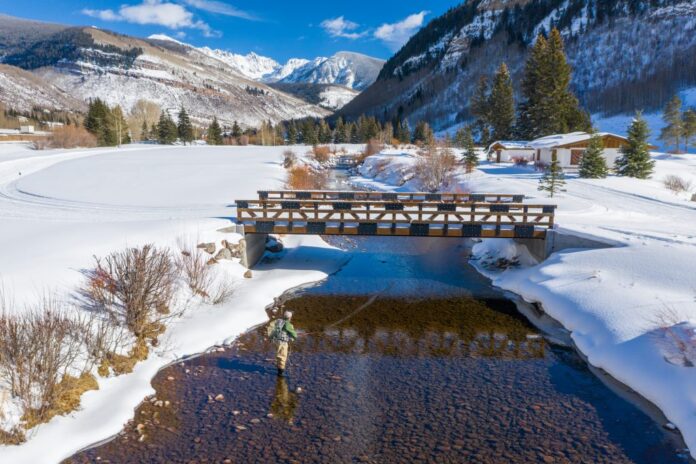Michael Salomone/Courtesy photo
Winter fly fishing provides an escape from the hurried activity of the ski slopes. Quiet and framed in white, the river leads anglers away from crowded parking lots. The snow weighs heavy on pine branches pulling boughs downward like thick frosting dripping off holiday gingerbread houses. But it’s not always, snow globe perfection. Unprepared anglers can find winter hazards carry a heavier weight.
Pre-trip preparation is critical for ensuring a comfortable, safe and productive winter fly fishing adventure. You don’t want to pull up beside the river and hop out in your Levi’s. Dressing in layers under your waders builds warmth that radiates from your core. Starting with the base, anglers improve the productivity of polypropylene, fleece and down by dressing in layers.

Michael Salomone/Courtesy photo
Polypropylene manages perspiration effectively by moving moisture away from the skin. Unlike cotton fabric that robs anglers of their insulating qualities, polypropylene starts the layering off right. Fleece is a beneficial next layer. The loft found in fleece elevates the warmth felt when activity increases.
Down or Primaloft insulating materials are effective in keeping your core toasty. Simms is the leader in wader manufacturing. Their knowledge of constructing the highest quality garments transcends into the Simms jackets as well. Found in both types of insulation materials, Simms jackets fight wintry winds, and chilly shadows on cold walks. And the hoods on all Simms jackets are integral components of the layering system, not just dysfunctional fabric hanging on your back.

Michael Salomone/Courtesy photo
To complete my shingled layers I top the whole thing off with an oversized Gore-tex jacket from Orvis. While some anglers get away with the down or Primaloft layer as the top coat, I prefer the resilience of a durable Gore-tex material to wrap everything up. The top coat enhances the performance of all the layers.

Support Local Journalism
Ice is an evil that takes a tremendous amount of time to understand. Ice is constantly changing on the river. Warm sunshine scours channels in ice shelves that can weaken hard water. Tumultuous currents wear at ice from underneath, thinning ice in an unpredictable manner.
Knowing the depth of the river under the ice is imperative to winter wading safety. Most of the river is in low water mode. Maintaining awareness of the river ice while angling is a necessity.

Michael Salomone/Courtesy photo
Cold nights that build slush ice and feed the formation of anchor ice change the river rapidly from one day to the next. Slush ice accumulates creating weak ice that should never be trusted. Anchor ice forms on the bottom of the river and can be a difficult obstacle to wading anglers that venture down into the water. Never walk on ice that you know is over deep water. Soft pockets, thin ice sections or fractured shelves can suddenly release, shatter or give way. Always be prepared for those moments.
The best way to maintain safety is with another angler. Wet ice is difficult to gain purchase on, whereas a co-angler can always lend a hand. Anglers that inadvertently end up wet should be concerned with self-preservation. A vehicle close by, a fire-making kit to warm beside the river and coffee or hot cocoa in a thermos reheats chilled anglers. Hypothermia changes the objective for the day quickly.
It is important to state that the issues with your waders are compounded when applied to winter wading. That slightly damp right sock is a danger in the winter that can not be ignored. Waders must be in tip-top shape. Any pinhole leaks or abrasion wear points need to be addressed or do not enter the winter water. Wool socks help keep toes toasty but any moisture that forms on the inside, even excessive sweat, can lead to a shortened, less enjoyable angling experience.
The freeze doesn’t just affect anglers. Opposing hazards exist for the trout. Cold air can freeze fragile gills and glaze over eyes when trout are lifted from the water. Keeping a fish in the water in a net is the best way to minimize the effects of frigid conditions on exposed fish. Keeping them wet is even more paramount during the winter.
Safety is more important in winter angling. Hazards carry more weight, are more extreme. Ice is an obstacle winter anglers need to overcome, whether it is the river ice shelf or the slush ice floating freely. Understanding the issues surrounding winter fly fishing enhances your snowbound angling experience. Chasing trout under a gently falling snow is a memory that won’t ever fade from your Vail Valley vacation.
Michael Salomone moved to the Eagle River valley in 1992. He began guiding fly-fishing professionally in 2002. His freelance writing has been published in magazines and websites including, Southwest Fly Fishing, Fly Rod & Reel, Eastern Fly Fishing, On the Fly, FlyLords, the Pointing Dog Journal, Upland Almanac, the Echo website, Vail Valley Anglers and more. He lives on the bank of the Eagle River with his wife, Lori; two daughters, Emily and Ella; and a brace of yellow Labrador retrievers.
Credit: Source link






























